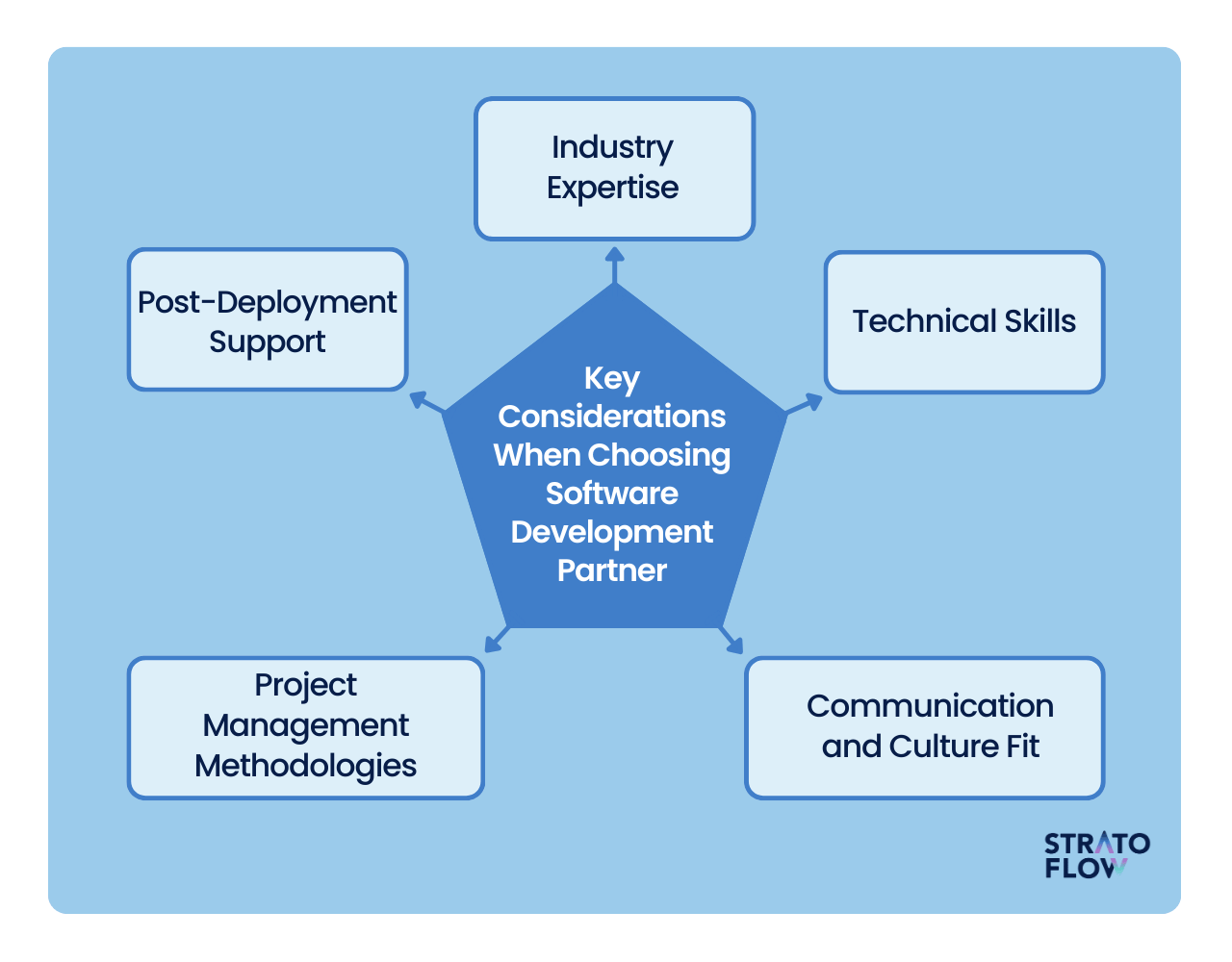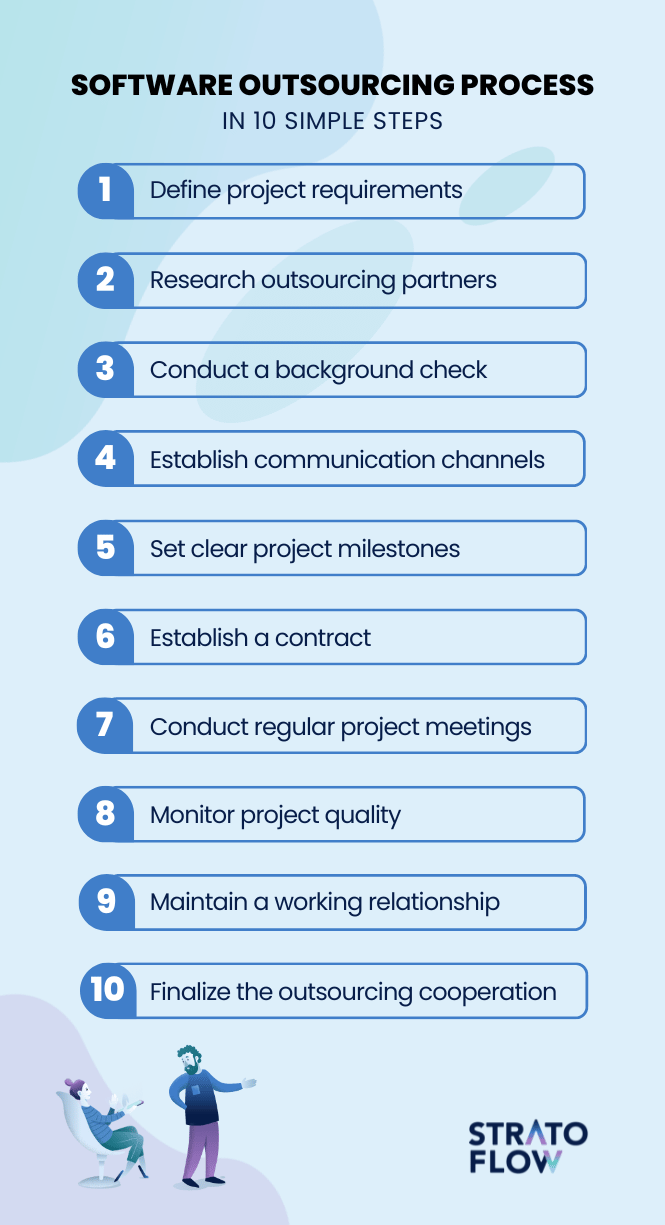
Outsourcing vs. Insourcing: An In-Depth Comparison to Guide Your Business Strategy
When evaluating business strategies, the choice between outsourcing vs insourcing is crucial. Our comparison helps you understand how each approach works in the IT industry. We cover how they impact costs, control, expertise, and business goals—vital information that will guide you as you navigate this critical decision.
Contents
- Understanding the key differences between insourcing and outsourcing in IT
- Insourcing in IT
- Outsourcing in IT
- Comparing operational impacts: insourcing vs outsourcing
- Financial considerations in Insourcing vs. Outsourcing
- Strategic planning of your IT project: aligning with business needs
- Transitioning between insourcing and outsourcing
- Key statistics about outsourcing and insourcing
- Frequently Asked Questions
Key Takeaways
- Insourcing gives you control and aligns with company culture but can be pricey with upfront training and equipment costs, while outsourcing saves money and gives access to a pool of specialized skills.
- The financial impact is key in choosing between these strategies: insourcing has high initial costs but can yield long-term benefits, while outsourcing offers short-term savings and flexible expertise access.
- Strategic fit is crucial; assess business processes and goals to align your IT strategy with your business needs, whether that means insourcing for control or outsourcing for cost-effectiveness and specialized skills.
Understanding the key differences between insourcing and outsourcing in IT
When it comes to managing IT, insourcing and outsourcing are two distinct options with their own advantages and disadvantages.
Insourcing refers to assigning tasks to your company’s internal employees, using the resources within your organization to handle IT challenges.
On the other hand, outsourcing involves entrusting IT responsibilities to an external provider who specializes in offering these services – usually a dedicated outsourcing provider.

Insourcing in IT
Insourcing is the practice of utilizing your organization’s internal team to handle IT tasks.
This approach allows for greater control over projects and aligns well with company culture and values. It can reduce costs and also foster a sense of ownership and dedication among employees.
Insourcing may not always be the most cost-efficient option due to potential investments in training, equipment, and infrastructure that are necessary for using in-house resources.
Why insourcing?
Deciding to adopt insourcing as a strategy for IT management is often driven by the desire to establish an internal team and maintain core competencies within your core business functions.
Insourcing allows you to have full control over your IT projects, ensuring that they align closely with the company’s values, goals, and culture.
Before making this decision, careful consideration must be given due to its impact on resource allocation and overall operational framework of the organization.
Building a dedicated internal team
Creating an internal IT team requires attracting qualified employees and promoting a positive workplace atmosphere.
By having common objectives and showing mutual respect, a committed in-house team contributes to building strong company values while improving communication and cooperation between internal teams.
Forming an in-house group comes with significant initial costs such as recruitment fees, competitive salary packages, and training expenditures.
Preserving core competencies
Insourcing provides several benefits, one of which is the maintenance and improvement of core competencies within your company. By keeping important tasks in-house, you and existing employees are able to have more control over service quality and ensure efficient delivery. This also helps with aligning these functions with your business objectives and strategic goals.
Insourcing creates a sense of ownership among employees, leading to increased loyalty towards the organization. As a result, this leads to better operational continuity and stability as key responsibilities remain within the team’s expertise rather than being outsourced externally.

Outsourcing in IT
Outsourcing involves the delegation of IT tasks to an external service provider, which can result in significant cost savings.
By utilizing the expertise of outsourced teams at a lower rate compared to maintaining equivalent skills internally, businesses can achieve financial benefits.
Partnering with outsourcing companies allows for flexibility in meeting operational needs and aligning with business strategies.
This means that resources dedicated to IT services can be easily adjusted to meet changing needs or long-term plans. This is done without disruption by leveraging specialized skills provided by third-party providers, rather than being handled solely by the company’s internal team.
[This may interest you: How to Choose a Software Development Company in [CHECKLIST]]
Leveraging external expertise
Transferring IT responsibilities to external providers offers various advantages such as:
- Saving costs
- Obtaining specialized skills that may not be available within the company
- Having access to a global pool of talented individuals
- The ability to concentrate on essential core business tasks and functions.
Cost savings through outsourcing partners
A major benefit of business practice of outsourcing is the ability to save a significant amount of financial resources.
By utilizing outside resources and knowledge, labor costs can be greatly reduced.
This strategy allows for:
- fixed IT costs to become flexible expenses,
- giving more control over budgeting
- allowing resources to be reallocated towards areas that generate higher profits within the company.
[Learn more: How to Estimate the Cost of Software Development [Experts Insights]]

Accessing specialized skills
Using outsourcing services also provides access to a wealth of specialized skills.
By delegating IT tasks to dedicated software developers, businesses can enlist the expertise needed to keep pace with constant technological advancements.
Some examples of these specific skill sets provided through an outsourcing company include software development, cybersecurity, cloud computing and data analysis.
Outsourcing offers companies the opportunity to tap into a diverse offshore talent pool from around the world, ensuring they have access to the skills they need when they need them.
Comparing operational impacts: insourcing vs outsourcing
The operational implications must be carefully considered when comparing the choice between insourcing and outsourcing.
Each approach presents its own advantages and challenges, particularly in terms of maintaining quality control and managing security risks.
In order to fully understand these considerations, let us take a closer look at each aspect individually.
Quality control is an important factor that should not be overlooked in determining whether to keep these specific tasks within the company or outsource them. Potential security risks also play a crucial role in this decision.

Quality control across business models
In the implementation of any business model, ensuring high quality control is crucial.
When you outsource, you have complete authority over the processes. This ensures consistent compliance.
On the other hand, outsourcing can make it difficult to maintain a similar level of quality because external teams may not share your company’s values and principles.
These challenges can be effectively handled through thorough auditing techniques and well-defined requirements.
By closely monitoring outsourced work and clearly defining expectations beforehand, businesses can overcome potential discrepancies in quality control with their external partners.
Navigating security risks and intellectual property concerns
In the modern digital era, safeguarding data security and protecting intellectual property are crucial.
When companies decide to handle operations internally (insourcing), they can effectively shield confidential information and reduce potential threats by keeping their sensitive data in-house.
On the other hand, outsourcing could either decrease or heighten security risks depending on certain factors such as implemented safety measures and reliability of the chosen service provider.
[Follow up reading: The Complete Guide to Software Outsourcing: How to Make it Work for Your Business]
Financial considerations in Insourcing vs. Outsourcing
In the decision process of insourcing or outsourcing work, the financial implications are very important.
Understanding these implications can help determine whether it is more financially viable to invest in an internal team for a long-term return on investment or opt for immediate cost savings through outsourcing.
Considering factors such as building and maintaining an in-house team versus outsourced services can help make an informed choice between the two options.
Long-term ROI of insourcing
The adoption of outsourcing can bring about significant advantages in the long run.
Building a specialized internal team creates a sense of responsibility and dedication which can result in substantial profits over an extended period.
The initial expenses related to insourcing, such as recruiting and training expenditures, may be considerable.
Short-term benefits of outsourcing
In contrast, outsourcing can offer immediate advantages, especially in terms of reducing expenses.
By leveraging external resources, you can significantly reduce labor costs and turn fixed IT expenses into variable ones.
By outsourcing certain tasks or processes, you are able to tap into specialized abilities and knowledge that may not be available within your company.
This allows for prompt access to the specialized expertise needed by your business.
For instance, at Stratoflow, we’re experts in ecommerce, travel and finance. When you’re looking for specialized service, choosing a company like ours ensures that your project benefits from focused expertise and deep industry knowledge, providing you with reliable and skilled guidance tailored to your specific needs.

Strategic planning of your IT project: aligning with business needs
When considering whether to insource or outsource, it is important not to make this decision in isolation.
It should be integrated into your overall business strategy, taking into account your specific needs and goals.
Evaluating business processes involves examining their effectiveness and tailoring IT solutions to provide a competitive advantage.
This includes analyzing current business practices and identifying areas where improvements can be made through personalized technology strategies that give you an advantage over competitors.
We suggest you to follow our experts tips on how to find software developers here.
Choosing the right software developers is critical, and it starts with deciding between nearshore and offshore options.
Nearshore developers offer closer collaboration and cultural similarities, while offshore developers can offer cost savings and a broader talent pool.
It’s important to consider expert advice on how to find software developers. Focus on clear project requirements, verify developer expertise, and ensure robust communication channels. Carefully consider these factors to ensure a partnership that best supports your project goals.

Assessbusiness processes and goals
To begin strategic planning, it is important to evaluate the business processes and objectives of your company.
By having a clear understanding of your specific needs and goals, you can make an informed decision on whether insourcing or outsourcing is in line with your overall business strategy.
This involves:
- identifying essential business processes,
- establishing SMART (specific, measurable, achievable,relevant, and time-bound) objectives,
- consistently monitoring performance to ensure that they align with the desired outcomes for your company’s strategy.
Tailor solutions for competitive edge
To stay competitive in today’s fast-paced business world, it is critical to customize your IT solutions.
Whether you choose to do everything in-house or outsource certain tasks, your approach should be tailored to support your business goals and give you an edge over the competition.
This may include implementing cutting-edge technologies, leveraging marketing strategies, applying industry best practices, or tapping into specialized knowledge and skills.
[Learn how to prepare for outsourcing software development]
Transitioning between insourcing and outsourcing
The decision to insource or outsource is a critical strategic step that should not be taken lightly.
Whether the direction is from outsourcing to insourcing or vice versa, it requires careful planning and evaluation of various factors such as business processes, objectives, security risks, and intellectual property concerns.
From outsourcing to insourcing
Transitioning from outsourcing to insourcing is a complex undertaking that often involves significant organizational changes.
Making this shift can bring various potential advantages such as greater control over business processes, improved alignment with company culture, lower labor costs and increased protection of intellectual property.
To ensure a smooth transition, meticulous planning is crucial.
This includes giving attention to recruiting and training new employees who will take on the outsourced tasks previously handled by external parties.
Adapting existing business processes for in-house operations. And investing in necessary technology and equipment.
Switching to outsourcing providers
Transitioning to business process outsourcing, such as knowledge process outsourcing, can bring about new possibilities for your company by providing access to a wider pool of skilled workers and the potential for significant cost reduction.
This shift also brings its own set of challenges that must be addressed carefully.
These include ensuring quality control standards are maintained, safeguarding intellectual property rights, and effectively managing relationships with external providers.
Achieving success in this transition largely depends on open communication channels between all parties involved, thorough planning beforehand, and selecting a reliable outsourcing firm or partner.

Key statistics about outsourcing and insourcing
When deciding between insourcing and outsourcing, it can be beneficial to examine current trends and data within the industry.
For example, estimates show that by 2028, the global market for IT outsourcing will reach a staggering US$777.70 billion, reflecting the increasing popularity of this approach.
About 37% of small businesses use outsourcing for functions like IT, HR, customer service, and data protection. Accounting and IT services are the most outsourced jobs, making up 37% of all outsourced roles, followed by digital marketing at 34%.
Increased efficiency is a key driver for outsourcing, cited by 24% of small businesses (Clutch). Other reasons include access to expert help, increased flexibility and more free time for employees.
According to Statista, the IT outsourcing market was projected to reach a value of $460.10 billion in 2023, with the highest revenue generation expected in the United States. The sector is anticipated to grow further, reaching $777.7 billion by 2028 at an 11.07% CAGR.
Why should I outsource to Stratoflow?
When considering outsourcing and IT staff augmentation, it is crucial to carefully select the right partner.
Stratoflow is a renowned IT outsourcing provider with an impressive track record of successful projects spanning various industries: ecommerce, travel, finance, healthcare.
Collaborating with us offers access to our vast expertise and dedicated resources, ensuring high-quality solutions tailored to your specific business requirements.

Summary
The decision of whether to insource or outsource should be carefully considered, taking into account the specific needs and requirements of your business, as well as the financial implications and operational effects. Whether you opt for establishing an internal team or utilizing the services of an external provider, it is essential to develop a robust IT strategy that aligns with your business objectives in order to gain a competitive edge and ensure success for your company.
Related Posts
- How to Find App Developers Near Me in 2024? Comprehensive Guide
- How to Find and Hire Full Stack Developers in 2024: Guide + Best Practices
- How To Hire Dedicated Developers in Europe [Benefits & Models]
- Software Development Process: Comprehensive Guide
- How to Start a Staffing Agency: A Comprehensive 2024 Guide
Thank you for taking the time to read our blog post!
Frequently Asked Questions
What is an example of insourcing?
Insourcing can be observed when a manufacturing company chooses to establish its own internal team for the production line instead of relying on an outside supplier. This decision enables the organization to retain complete control and authority over their production process and also helps in reducing expenses.
In this scenario, rather than outsourcing tasks, companies opt for creating in-house teams which allows them more control and cost-cutting benefits. By building an in-house workforce within their premises, businesses have better oversight over various aspects of their operations.
What is the difference between outsourcing and?
Outsourcing involves hiring an external vendor to take care of certain tasks, while offshoring entails moving all business operations to a different location.
For instance, specific duties such as customer service can be outsourced to a BPO company based in the Philippines. This allows businesses located elsewhere to still benefit from skilled labor and lower costs by delegating these responsibilities abroad through outsourcing.
How do you know when to insource or outsource?
You should insource when the position is critical to the business and must be kept in-house for reasons like risk and compliance, while outsourcing is preferable when the job is non-core and you want to save money or compete for talent.
Consider restructuring if you already have employees adept in the area, but if no one has the relevant expertise, outsourcing may be essential.
What are the main differences between insourcing and outsourcing in IT?
The main differences between insourcing and outsourcing in IT boil down to using internal resources versus delegating tasks to an external third party service provider. Both approaches have their pros and cons, and the decision usually hinges on a business’s unique needs and goals.
What are the benefits and challenges of building a dedicated internal IT team?
Forming a specialized in-house IT team has the potential to enhance company culture and facilitate better communication. It may involve a significant upfront cost for recruiting, educating, and equipping employees with necessary tools.
Where are the best software development companies located?
Poland is one of the most attractive IT markets in Central and Eastern Europe. This country has emerged as a leading destination for software development, attracting global attention for its highly skilled workforce, strong emphasis on technical education, and vibrant technology industry. The country’s growth in outsourcing is remarkable, driven by its developers’ expertise, English language skills, and commitment to quality. These factors, combined with a favorable business environment, position Poland as a preferred hub for outsourcing high-quality software development services.